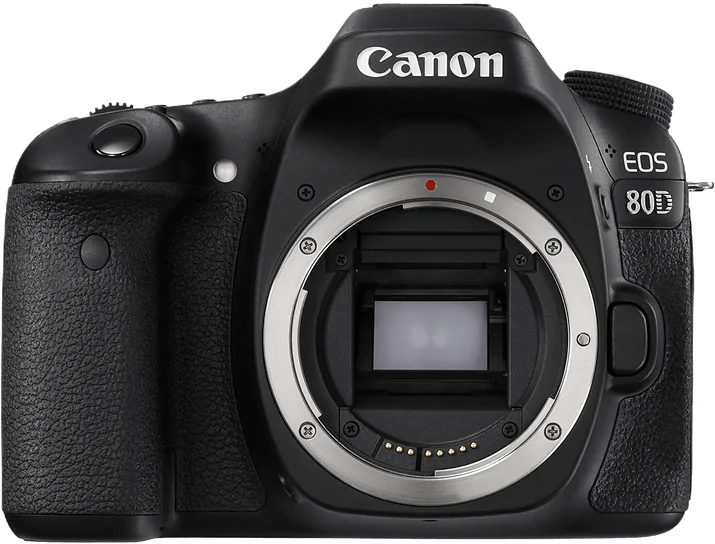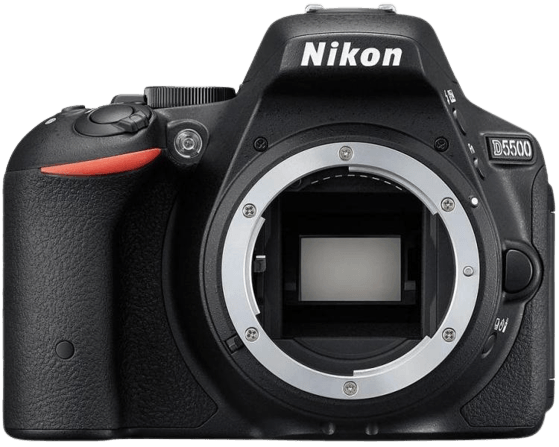Canon EOS 80D vs Nikon D5500 Comparison
Canon EOS 80D

Nikon D5500

The Canon EOS 80D edges out the Nikon D5500 with a score of 64/100 compared to 61/100. Both cameras are DSLRs, released in 2016 and 2015 respectively. They share some common specifications, such as camera type and launch price, with the 80D priced at $1200 and the D5500 at $900.
The Canon EOS 80D has the advantage in size and weight, measuring 139 x 105 x 79mm and weighing 730g (1.61lbs). This larger size may offer better ergonomics and handling for some users. On the other hand, the Nikon D5500 is lighter and more compact, measuring 124 x 97 x 70mm and weighing 420g (0.93lbs), making it easier to carry around.
Considering these specifications, the Canon EOS 80D offers a slightly better overall experience, while the Nikon D5500 may be more suitable for those looking for a lighter and more portable option.
Canon EOS 80D vs Nikon D5500 Overview and Optics
The Nikon D5500 wins the optics comparison with a score of 65/100, while the Canon EOS 80D scores slightly lower at 63/100. Both cameras share some specifications, such as having 24.2 megapixels, a CMOS sensor, APS-C sensor size, and no image stabilization. Additionally, both cameras use different processors, with the Canon 80D using a Digic 6 processor and the Nikon D5500 using an Expeed 4 processor.
The Nikon D5500 is better in terms of its sensor performance, as it has a higher DXOMARK score of 84 compared to the Canon 80D’s score of 79. This advantage enables the Nikon D5500 to produce better image quality. Furthermore, the Nikon D5500 uses a Nikon F DX lens mount, which provides a wide range of compatible lenses for various purposes.
On the other hand, the Canon EOS 80D has a faster shooting speed of 7 frames per second, compared to the Nikon D5500’s 5 frames per second. This feature makes the Canon 80D more suitable for capturing fast-moving subjects, such as sports and wildlife photography. Additionally, the Canon 80D uses a Canon EF-S lens mount, which also offers a broad selection of lenses.
In terms of optics, the Nikon D5500 is a better choice due to its higher sensor performance. However, the Canon EOS 80D’s faster shooting speed may be more appealing to photographers who prioritize capturing fast-moving subjects. Both cameras have a wide range of compatible lenses, making them versatile options for various types of photography.
Canon EOS 80D vs Nikon D5500 Video Performance
The Canon EOS 80D and Nikon D5500 both have a video score of 70/100, indicating that their video capabilities are evenly matched. They share some common specifications, such as Full HD video resolution, maximum video dimensions of 1920 x 1080, a maximum video frame rate of 60fps, and built-in time-lapse functionality.
However, there are areas where one camera may outperform the other. For the Canon EOS 80D, its advantages lie in its autofocus system, which is known for being fast and accurate. This feature is crucial for capturing high-quality video, as it ensures that the subjects remain in focus throughout the recording. Additionally, the Canon EOS 80D has a slightly larger and more ergonomic body, which can make it more comfortable to hold during extended video shoots.
On the other hand, the Nikon D5500 has a smaller and lighter body compared to the Canon EOS 80D, making it more portable and easier to carry around during travel or outdoor shoots. Its touchscreen capabilities also make it more user-friendly, allowing for quicker adjustments to settings while recording video. However, it should be noted that the Nikon D5500’s autofocus system may not be as efficient as the Canon EOS 80D’s.
Taking these factors into consideration, it is clear that both cameras offer solid video capabilities with a few advantages unique to each model. The Canon EOS 80D is a better choice for those who prioritize autofocus performance and ergonomics, while the Nikon D5500 is ideal for users who value portability and ease of use with its touchscreen interface. Ultimately, the decision will come down to individual preferences and the specific requirements of the user.
Canon EOS 80D vs Nikon D5500 Features and Benefits
The Canon EOS 80D wins the features comparison with a score of 70/100, while the Nikon D5500 scores 59/100. Both cameras share several specifications, such as a touchscreen, flip screen, WiFi connectivity, and the lack of GPS and Bluetooth.
The Canon EOS 80D has a slightly higher screen resolution at 1,040,000 dots compared to the Nikon D5500’s resolution of 1,037,000 dots. This difference gives the Canon EOS 80D a marginally better display, providing clearer images and easier navigation through menus. Furthermore, the EOS 80D’s higher feature score indicates its overall superiority in terms of performance and functionality.
On the other hand, the Nikon D5500 has a larger screen size at 3.2 inches, compared to the Canon EOS 80D’s 3-inch screen. This larger screen allows for better framing and easier use of the touchscreen, providing a more enjoyable experience for the user. However, this advantage does not compensate for the overall lower feature score of the Nikon D5500.
In conclusion, the Canon EOS 80D is the better camera in terms of features, as evidenced by its higher score. Its slightly higher screen resolution offers a better viewing experience, and its overall performance and functionality surpass that of the Nikon D5500. While the Nikon D5500 has a larger screen size, which may be preferable for some users, it does not outweigh the advantages offered by the Canon EOS 80D.
Canon EOS 80D vs Nikon D5500 Storage and Battery
The Canon EOS 80D outperforms the Nikon D5500 in storage and battery with a score of 43/100, while the Nikon D5500 scores 35/100. Both cameras have one memory card slot and accept SD, SDHC, and SDXC memory cards. Neither camera has USB charging capabilities.
The Canon EOS 80D’s superior score is due to its longer battery life, lasting for 960 shots compared to the Nikon D5500’s 820 shots. The 80D uses an LP-E6N battery, providing more shooting time before needing a recharge.
The Nikon D5500, although scoring lower, still offers a decent battery life of 820 shots using its EN-EL14 battery. This difference in battery life may not be significant for some users, depending on their shooting habits and requirements.
Taking these factors into account, the Canon EOS 80D proves to be the better choice in terms of storage and battery life, providing users with a longer-lasting shooting experience.
Canon EOS 80D vs Nikon D5500 – Our Verdict
Are you still undecided about which camera is right for you? Have a look at these popular comparisons that feature the Canon EOS 80D or the Nikon D5500:

